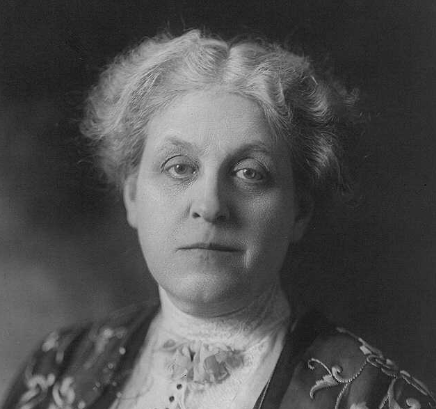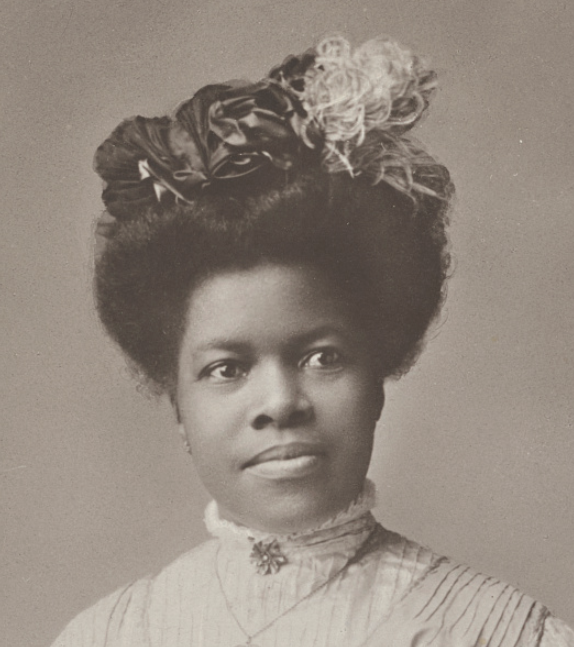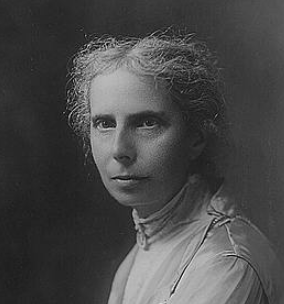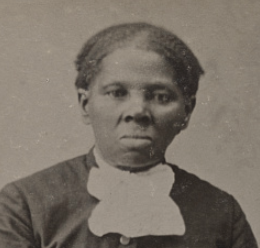
I found this free tool that uses AI to create then and now images from your text instructions. GliF: Then and Now You can sign in for a free account using Google.
There are two text boxes - Then and Now. You enter your instructions and in a few seconds you get the image.
For example: I created the image above with:
Then: 19th century peasant immigrant family in Eastern European traditional outfits exiting boat on dock in front of Statue of Liberty. sepia tone
Now: Color image in the same location. Same dock structure and Statue of Liberty in alignment.
You'll see that the product lacks historical accuracy - but I think it could be a fun activity starter. Try it out and leave some comments or samples and let's see if we can figure out some good lesson ideas
Here's another one I made. AI "hallucinated" some strange bikes and an inaccurate White House with a rather low fence.

Then: 19th century cyclists - male and female riding historical bikes in historical attire in front of White House
Now: Color photo of White House from same perspective. Make sure then and now White House line up.
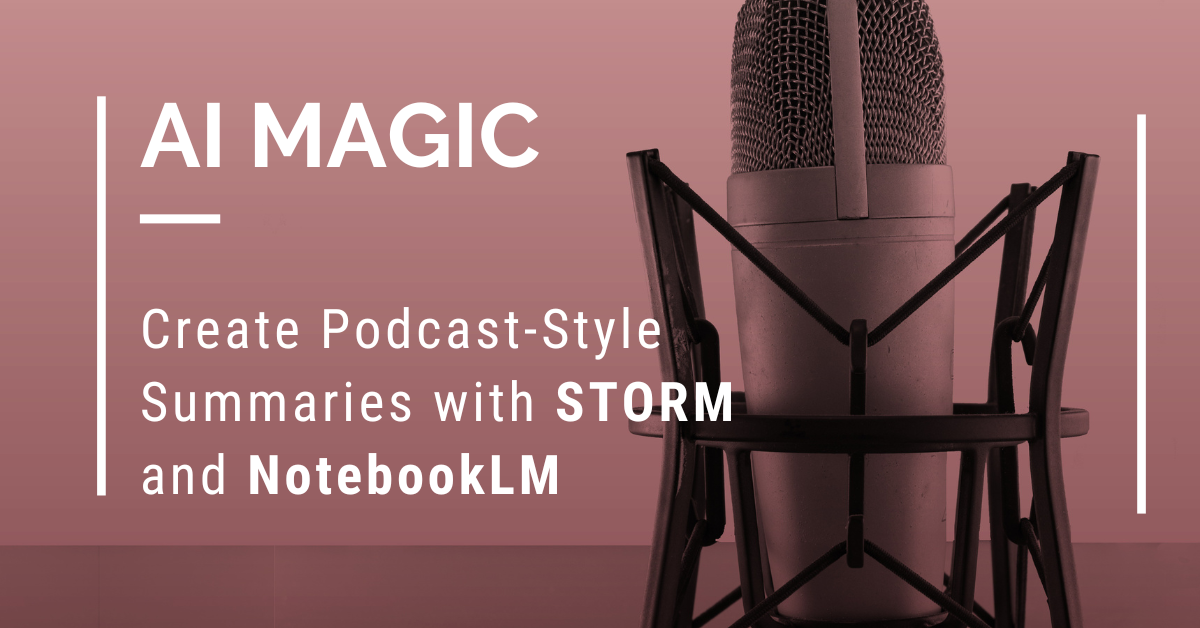
Building on yesterday’s post, “Transform History into Podcasts with AI,” this post (from my personal website) takes things a step further by offering more detailed guidance on how to use STORM and NotebookLM together. If you’re looking for a powerful way to streamline research and turn it into podcast-style summaries, this post will walk you through the process, helping you make the most of these innovative AI tools.
Imagine this: you've got a mountain of research, articles, PDFs, and notes staring back at you. Instead of sifting through it all, what if AI could pull the best bits and hand you a podcast-style summary? Magic, right? Well, thanks to tools like STORM and NotebookLM, it's more than possible--it's a breeze!
In this post, I'm going to show you how to harness the power of these two AI wizards to take your research from the page (or PDF or website) to your earbuds--turning hours of reading into minutes of listening. And here's the kicker--it took me less than 10 minutes to pull off a podcast-style summary using both tools.
Continued here: https://peterpappas.com/2024/09/ai-magic-create-podcast-style-summaries-with-storm-and-notebooklm.html

Have you ever wished you could turn a dense historical text into a fun, engaging conversation? Google’s new NotebookLM tool makes it possible to do just that! NotebookLM analyzes text sources—whether they’re primary sources, articles, or textbooks—and turns them into conversational summaries. Imagine using it to create a short, chatty podcast that brings history to life! In this post, we’ll explore how NotebookLM works and offer creative ways for social studies teachers and students to use it in the classroom. PS: NotebookLM has lots of other useful tools for summating uploaded content.
What is NotebookLM?
NotebookLM is an AI tool designed by Google that takes long, sometimes complicated text and distills it into a more accessible, conversational format. Whether you’re working with a textbook chapter, historical document, or article, you can use NotebookLM to summarize key points in a casual, podcast-ready style. It’s ideal for generating podcast scripts that explain historical events or concepts in an engaging way—and it works with all kinds of text sources!
In this example I pasted the URL from this LOC page about Woman's Suffrage into a new "Notebook"
Link to Audio File:Womens Suffrage Test (20mb wav file)
Step-by-Step Guide:
1. Upload Text or Links: Start by uploading the text you want to work with. This could be a historical speech, newspaper article, or a primary source from the Library of Congress collection. It can also be mulitple sources
2. Generate Chatty Summaries: Once you have created Notebook with sources - click on the *Notebook Guide in the lower right of the screen
3. A Notebook Guide page will pop up - You will see Audio Overview area in upper right of popup. Click "Load the Conversation"
4. In a few seconds an Audio Overview will load. Click the 3 dots to download
5. Save the WAV file and share
Note: You have no controls over the script it creates or voices used. It cannot be edited.
Creative Classroom Applications for NotebookLM
Here are some ideas for how teachers and students can use NotebookLM to explore history in innovative ways:
1. Student-Created Podcasts
Students can turn historical documents into podcast. This encourages them to engage with primary sources in a new way.
Example: A student creates a podcast about the Gettysburg Address, exploring its significance while breaking it down into bite-sized, conversational insights.
2. A Summary Tool for Dense Texts
For those long textbook chapters or articles that can be overwhelming, NotebookLM acts as a summary tool. Teachers or students can input the text and receive a concise, digestible summary. It’s a fantastic way to break down complex historical events like the Civil Rights Movement or the Industrial Revolution into manageable pieces for study sessions.
Example: Use NotebookLM to summarize a chapter on the Progressive Era, creating a quick review that students can listen to before a test.
3. Class Reviews of Historical Eras
NotebookLM can help teachers and students quickly review entire historical periods, like Reconstruction or World War II, by summarizing key events into short podcast segments. These can be used as study aids or class-wide discussions that reinforce the material in an engaging, audio-friendly format.
Example: A teacher uses NotebookLM to create a five-minute podcast summarizing the major events of the Reconstruction era, which students listen to before diving deeper into the topic.
Final Thoughts
AI tools like Google’s NotebookLM are reshaping how students engage with historical content, turning texts into dynamic, audio-friendly formats that meet them where they are. Imagine the impact of a student-created podcast that not only explains a historical event but also connects it to the present day. These podcasts can become powerful tools for reflection and discussion, encouraging students to think critically about the past while presenting it in a way that’s accessible and fun.
Give NotebookLM a try in your classroom—and share your podcasts with us! Let’s bring history to life, one conversation at a time.
Two Library of Congress blog posts
These insightful blog posts each with a very different focus, reminded me how photo research and analysis as well as photomontages can create a story or emphasize the diversity we see in each of us.
- Timeless stories from the Library of Congress Du Bois and the Paris Exposition of 1900: Three Pictures by Lauryn Gilliam
- Picture This Library of Congress Prints & Photos A Giant visitor to New York City by
 Kristi Finefield
Kristi Finefield
As I see from Lauryn Gilliam’s post, each face and photo speaks to us individually. And the technology of photomontage as shared by Kristi Finefield is not new and can create a unique story or emphasize a point.
Connecting the two
The W.E.B Du Bois collection that Lauryn Gilliam describes is one of my favorites for photography, civil rights, African American History and culturally relevant pedagogy. Also Du Bois’ powerful story, told through images and graphs of the struggle and resilience of our ancestors, was the multimedia of its time.
To extend that lesson with a photomontage technique that Kristi Finefield shared is easily accomplished with the digital technology of today.
Blending story telling and analysis, students might select a favorite individual image image from a group, photo, lift out and analyze or reflect on that person’s story. Below are my simple examples.

https://www.loc.gov/item/95507126/

https://www.loc.gov/item/95502382/
Or Students might apply a montage to one of Du Bois’ statistical graphs to emphasize the connection of the statistics about Georgia with the portriats of the people who were part of those statistics.



Perhaps I’ve connected two ideas that don’t mesh, but I hope they show how a historic photo technique, that we are often wary of today and a primary source can spark some thinking and digital creation - both important habits of mind in today’s world for students practice and learning.
W.E.B. Du Bois African American Photography Digital Art Technology Integration
This is such a creative Lab project from the Library of Congress Innovator in Residence Jeffrey Yoo Warren. https://labs.loc.gov/work/experiments/portals/.
I discovered it via the Worlds Revealed Geography and Maps at the library of Congress. Blog - Experience “Hidden Portals” this May.
“At the sites of 5 historical erased Asian American communities, portals have been hidden in plain sight. When you approach, the portals will open, allowing a glimpse into virtually reconstructed, immersive moments from their pasts.
Providence | Portland | Hanford | Riverside | Truckee and at the Library of Congress”
I’d love it if anybody from our TPS Teachers Network visits one of these sites either at the Library or at one of the locations and posts here about the experience. I know  Peter Pappas
has done historic work in Portland and published an interactive digital book in the Apple Book store Portlands Japantown Revealed. Is the Portland site close to you, Peter? Also folks at the Library, what is your experience?
Peter Pappas
has done historic work in Portland and published an interactive digital book in the Apple Book store Portlands Japantown Revealed. Is the Portland site close to you, Peter? Also folks at the Library, what is your experience?
I also wonder - How might students using Augmented Reality or other tools recreate something similar with primary sources in their schools or communities?
Frequently primary sources can tell the story of wartime racism, stereotyping, and government misinformation. I came across this film in the Internet Archives made by the U.S. Office of War Information Bureau of Motion Pictures (1943) that certainly provides an example.
https://dn790001.ca.archive.org/0/items/Japanese1943/Japanese1943.mp4

Lesson Idea
Challenge students to research photos in the Library of Congress on Japanese American Incarceration. Next they can design & create a Keynote using the built in Record Audio tool to capture their own narration that more accurately tells the story. They might even be able to interview family or community members to add to the narrative.
For example, how might students narrate these primary sources after researching valid sources on Japanese American Incarceration?
Certainly for history classes, viewing the film made by the Office of War Information Bureau of Motion Pictures and discussing, is one approach to learning. But having students work closely with the words and images to develop a media response takes that learning one step further. Asking students, “How do we correct misinformation or misrepresentation and misinterpretation of media?” and sending them on a media creation task, can lead to very powerful learning.
Resources:
- Ansel Adams's Photographs of Japanese-American Internment at Manzanar (Library of Congress)
- Forced removal and incarceration of Japanese Americans living in California during World War II (Images Library of Congress)
- Lost Liberty (Apple Books) Using Image Galleries.
I'm offering a workshop for educational leaders at AI Empowered EDU conference at the University of Portland on May 14. My session is called "Hands on with AI."
I created a website to support the workshop.
It gives tips on how to create prompts, best AI assistants, and sample prompts. The prompt library offers sample prompts useful for students, teacher and educational leaders
Here's the agenda.
Are you curious about the potential of artificial intelligence in education? Join our interactive workshop to explore how AI can enhance teaching and learning.
Visit the LLMs Page to see suggested AI assistants.
Agenda:
- Hands-On Exploration: Bring your own laptop and dive into practical activities. Collaborate with fellow participants in small groups as we explore AI tools and applications.
- Use Cases: Discover real-world examples of AI from the perspective of student, teacher and administrator. You'll explore prompts and scenarios that improve efficiency, spark creativity and enhance problem-solving.
- Tool Showcase: The session will feature custom website that showcases AI tools and methods relevant to education.
Image made with Co-pilot and prompt: "Time travel to interview Ben Franklin. Colorful and in a photo-realistic style"
Here's two ideas starters that you can easily adapt to your teaching and learning needs. The first is very basic. The second uses more context, steps and required outputs.
You can simply change the content from Franklin or colonial Pennsylvania to another person, time or place. Explore and experiment by adding more steps, specific outputs or constrains. For example you could ask for all responses to "be suitable for 3rd- 5th graders."
These could be designed for students to use as large group, teams or as individuals. Students could then be tasked with fact checking the AI output or using the AI output as a springboard to more study.
Interview a historical figure:
"Assume the role of Ben Franklin so that we can have an interactive Q and A session. Your responses should be historically accurate and in the voice of Franklin and his era."
Play a historical adventure game:
"You are an historian who likes to create text adventure games as engaging teaching tools. I'm studying history in high school. Create a text adventure game I can use to explore Colonial Pennsylvania and help me explore important people, events, and concepts in its geography and language.
Create it like a historically accurate story, teaching me about Colonial Pennsylvania while I'm interacting with it. Give me three paragraphs of story at a time. Then, stop and ask me to make a decision. Wait for my response before you continue the story in a way that's consistent with the decision I've made. Ideally, I'd like about 3 prompts before the story ends.
When the story ends, ask me a few questions that help me reflect on what I've learned."
Free AI chatbots to try:
Microsoft CoPilot (Select "Creative Mode") - https://copilot.microsoft.com
MetaAI - https://www.meta.ai
Google Gemini - https://gemini.google.com/app
Anthropic Claude - https://claude.ai/chats
Perplexity -https://www.perplexity.ai
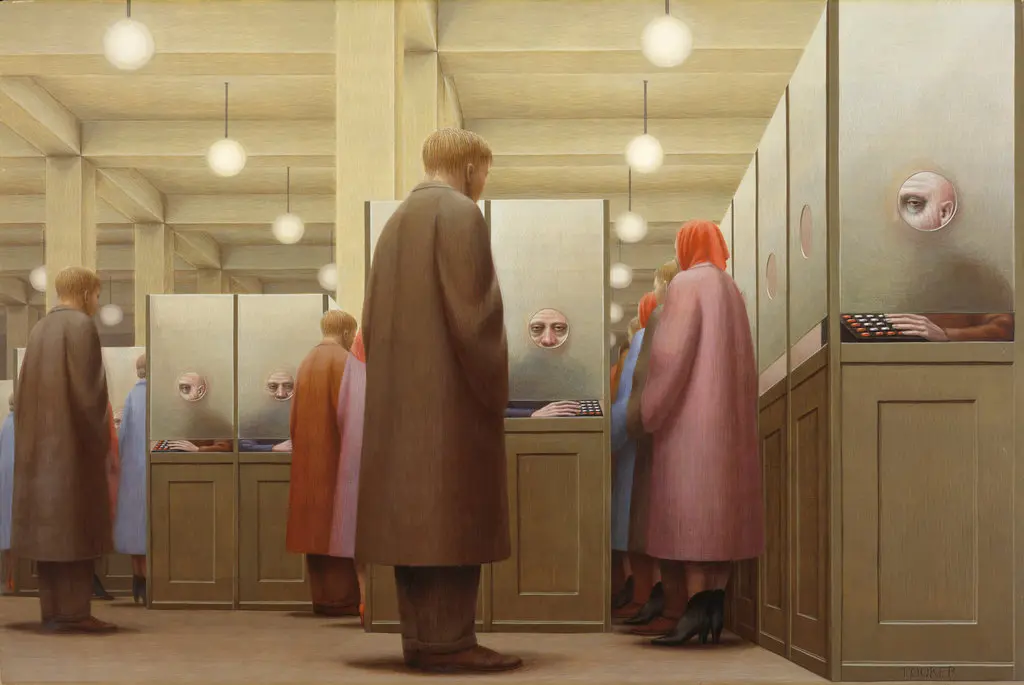
We’ve all grown accustomed to turning to search engines when struggling to remember a detail or fact. But recently I found myself in a situation where “Googling” was useless. I was trying to recall a work of art without knowing the artist, title, or even the country of origin.
Note: At some point in my life I had seen George Tooker’s “Government Bureau” (1956) – a striking image (above) that had burrowed into my memory. But I lacked the descriptors that would work in a traditional text-based search.
Armed with nothing but a vague sense of the era and the artwork’s elusive “feel,” I turned to Meta AI for assistance. What followed was a bit magical—a journey through memory cubicles that led me to the masterpiece I sought.
It began with this prompt ... see full post here
An interesting article: AI is creating fake historical photos, and that's a problem. I follow the author - Marina Amaral, who creates fascinating posts around historical black and white photos that she carefully colorizes.
It this post she write about the rise of AI-generated "vintage" photos that are "virtually indistinguishable from the real ones. They can mimic the grainy textures, the soft focus, and even the damages that I spend hours restoring and removing from the photographs that I work on."
She offers a number of examples. Here's a few:

As history teachers - we'll need to come to grips with this functionality as the technology becomes easier and more prevalent.
Here's two interesting TPS posts on the subject:
1. I've dabbled with using AI to alter historical photos. See: You can update "Migrant Mother." But Should You?
2. '"AI Imagery May Destroy History As We Know It" by  Soline Holmes
Soline Holmes
Testimonials
- I love that there is new info on the site daily!
- I had a wonderful time working with the Library of Congress and learning about all of the resources at my fingertips!
- The TPS Teachers Network has an equal exchange of ideas. You know it's not a place where you're being judged.
- My colleagues post incredibly fine resources and ideas....the caliber of the suggestions and resources make me feel that I take a lot from it. It's a takeaway. And I hope that I can give back as much as I get.
- Going into this school year, I have a fantastic new resource for my own instruction and to share with my colleagues!
- I am very glad that I discovered the TPS Teachers Network through RQI. Great resources can be hard to find out there on the internet!





